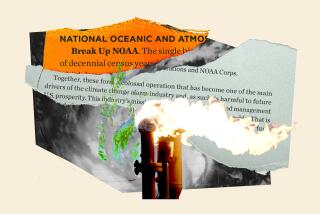Suggests Wearing Hats, Sunscreen Instead of Saving Ozone Layer : Hodel Proposal Irks Environmentalists
- Share via
WASHINGTON — Interior Secretary Donald P. Hodel has aroused the ire of environmentalists with a suggestion that people wear hats, sunglasses and protective sun creams to combat the added risk of skin cancer as man-made chemicals reduce the Earth’s protective ozone layer.
Hodel, a conservative Republican with a strong aversion to government regulation, is urging the Reagan Administration to consider such a “public awareness” campaign as one possible alternative to curbing the chlorofluorocarbon chemicals, or CFCs, that scientists generally agree are depleting ozone in the stratosphere.
As word of Hodel’s suggestion to a meeting of the Cabinet’s Domestic Policy Council last week spread around Washington on Friday, after reports in the Washington Post and Wall Street Journal, the Environmental Protection Agency reaffirmed the Administration’s commitment to an international agreement to control ozone-depleting CFCs.
Calls for Resignation
Nevertheless, several environmental groups called for Hodel’s resignation.
Groups such as Friends of the Earth and the Environmental Policy Institute in Washington said his suggestion indicates that the secretary of the Interior, whose agency is responsible for protecting the nation’s fish and wildlife, fails to understand the broad and potentially disastrous effects that increased ultraviolet radiation would have on the Earth’s climate, food chains and individual species of plants and animals other than humans.
Cheap and nontoxic, CFCs are widely used as refrigerants, in fire-extinguishing systems and--outside the United States--as aerosol propellants. In the stratosphere, they interact with and destroy ozone, a form of oxygen that screens out much of the sun’s ultraviolet light. According to one widely accepted estimate, each 1% reduction in the ozone layer can be expected to produce 20,000 additional cases of skin cancer in the United States annually.
Wearing Sunglasses
“People should wear hats, sunglasses and sun creams in strong sun, but that doesn’t mean we should blow away the Earth’s natural sunscreen,” David Doniger of the Natural Resources Defense Council said in a hastily summoned news conference.
“Animals, crops, fish and wildlife aren’t going to wear hats and sunglasses,” Doniger observed.
Conservationists promptly dubbed Hodel’s proposal the “Ray-Ban Plan.”
“Sounds fine with us,” a spokesman for the manufacturer of the sunglasses, Bausch & Lomb, in Rochester, N.Y., said with a laugh. The spokesman, Norman Selik, said that, if Hodel is serious, “we’ll be happy to set the Interior secretary up as a distributor of Ray-Ban sunglasses.”
‘Not a Serious Option’
At the White House, however, officials voiced skepticism that Hodel’s proposal would be adopted. Said one official: “It’s not a serious option.”
A spokesman for Hodel, David Prosperi, said he did not know precisely how Hodel had phrased his suggestion to the Cabinet council but did not deny that it stressed urging people to protect themselves from the sun.
“He has no particular affinity for a public awareness campaign on this issue. His view is that it should be one of several options presented to the President so he can make an informed decision based on the facts,” Prosperi said.
An aide to Hodel who asked not to be identified said an Administration policy that exclusively stressed regulation of CFCs would be out of line with President Reagan’s preference for minimizing government regulation. “What Hodel is saying is why should the President be boxed into an option . . . that conflicts with the Administration’s philosophy?” the aide said.
International Pact Sought
U.S. policy, endorsed by major manufacturers of the chemicals, has been to seek an international agreement to phase out the use of those chlorofluorocarbons that destroy atmospheric ozone, while encouraging the substitution of new varieties of the chemicals that do not interact with the Earth’s sunscreen.
The United States joined 30 other nations in Geneva last April in signing a tentative agreement under United Nations auspices that calls for a 20% reduction in CFC emissions by 1992. In a statement Friday, Lee M. Thomas, administrator of the Environmental Protection Agency, said the United States would continue to seek its original objective of a 95% reduction in the next decade.
“We are continuing our negotiations, and I believe an international agreement can be completed over the next several months,” Thomas said.
One of Hodel’s objections, an aide said, is that the U.S. negotiating position has not been formally reviewed and approved by the President or the Domestic Policy Council. He said Hodel plans to raise the issue at the council’s next scheduled meeting in June.
More to Read
Sign up for Essential California
The most important California stories and recommendations in your inbox every morning.
You may occasionally receive promotional content from the Los Angeles Times.













